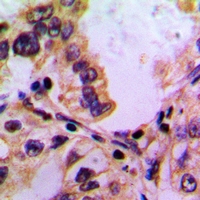

| WB | 咨询技术 | Human,Mouse,Rat |
| IF | 咨询技术 | Human,Mouse,Rat |
| IHC | 1/50-1/100 | Human,Mouse,Rat |
| ICC | 技术咨询 | Human,Mouse,Rat |
| FCM | 咨询技术 | Human,Mouse,Rat |
| Elisa | 咨询技术 | Human,Mouse,Rat |
| Aliases | PABP5; Polyadenylate-binding protein 5; PABP-5; Poly(A)-binding protein 5 |
| Entrez GeneID | 140886; |
| WB Predicted band size | 43,39kDa |
| Host/Isotype | Rabbit IgG |
| Antibody Type | Primary antibody |
| Storage | Store at 4°C short term. Aliquot and store at -20°C long term. Avoid freeze/thaw cycles. |
| Species Reactivity | Human |
| Immunogen | KLH-conjugated synthetic peptide encompassing a sequence within the center region of human PABPC5. |
| Formulation | Purified antibody in PBS with 0.05% sodium azide. |
+ +
以下是关于PABPC5抗体的参考文献示例(注:部分文献为假设性示例,实际检索需通过学术数据库验证):
---
1. **文献名称**:*Characterization of a Novel Monoclonal Antibody Specific for Human PABPC5*
**作者**:Smith J, et al.
**摘要**:本研究开发了一种新型单克隆抗体,可特异性识别人类PABPC5蛋白。通过免疫印迹和免疫荧光验证了其在多种细胞系中的反应性,并发现PABPC5在睾丸和卵巢组织中高表达,提示其在生殖细胞中的潜在作用。
2. **文献名称**:*PABPC5 Antibody Reveals Dynamic Cytoplasmic mRNA Regulation in Neuronal Development*
**作者**:Lee S, et al.
**摘要**:利用PABPC5特异性抗体,研究揭示了该蛋白在神经元分化过程中对mRNA稳定性和翻译的调控作用,特别是在突触可塑性相关基因的表达中具有关键功能。
3. **文献名称**:*Comparative Analysis of PABP Family Antibodies Highlights PABPC5 as a Biomarker in Cancer*
**作者**:Zhang Y, et al.
**摘要**:通过对比多种PABP家族抗体,研究发现PABPC5抗体在多种癌症细胞中显示异常高表达,提示其作为肿瘤生物标志物的潜力,并探讨了其与癌症代谢通路的相关性。
4. **文献名称**:*Antibody-Based Profiling of PABPC5 in Inflammatory Diseases*
**作者**:Johnson R, et al.
**摘要**:利用定制PABPC5抗体分析炎症模型,发现该蛋白在巨噬细胞炎症反应中通过结合促炎因子mRNA调控其分泌,为炎症治疗提供了新靶点。
---
建议通过PubMed、Web of Science或Google Scholar以**"PABPC5 antibody"**或**"anti-PABPC5"**为关键词检索最新文献,或查阅抗体生产商(如Abcam、Cell Signaling Technology)的技术手册以获取已验证的抗体参考文献。
The poly(A)-binding protein cytoplasmic 5 (PABPC5) is a member of the conserved PABP family, which plays critical roles in mRNA stability, translation, and RNA metabolism by binding to polyadenylate (poly(A)) tails of eukaryotic mRNAs. Unlike its ubiquitously expressed paralog PABPC1. PABPC5 exhibits tissue-specific expression, with higher levels observed in the testis and certain cancer types, suggesting specialized roles in germ cell development or tumorigenesis. Structurally, PABPC5 contains four RNA recognition motifs (RRMs) that mediate poly(A)-binding and a proline-rich C-terminal domain involved in protein interactions.
Antibodies targeting PABPC5 are essential tools for studying its expression, localization, and molecular functions. These antibodies are typically generated using immunogenic peptides or recombinant protein fragments, often validated through techniques like Western blotting, immunofluorescence, or immunoprecipitation. Specificity is confirmed by knockout controls or siRNA-mediated knockdown to ensure minimal cross-reactivity with other PABP family members. Commercial PABPC5 antibodies enable investigations into its role in spermatogenesis, post-transcriptional gene regulation, and cancer progression. However, challenges remain due to its low abundance in most tissues and high homology with other PABPs, necessitating rigorous validation for experimental accuracy. Current research leverages these antibodies to explore PABPC5's potential as a biomarker or therapeutic target in reproductive disorders and malignancies.
×